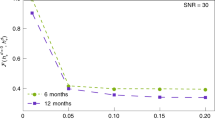Abstract
LATE in the nineteenth century and early in the twentieth century, British scientists such as Lamb1 and Love2had made theoretical predictions about the free oscillations of the Earth. The gravest mode was calculated to be about 1 h. Benioff3 in 1954 surmised that a signal with a 57 min period recorded during the Kamchatka earthquake might be the grave mode of the free oscillations of the Earth. Pekeris4 and his colleagues, stimulated by such predictions, were able to calculate the period of free oscillations of the Earth for a large number of modes, and these theoretical predictions were confirmed for the first time5,7 after the great Chilean earthquake of May 22, 1960. Easier numerical integration techniques for calculating different models of the Earth have since been introduced8 and other earthquakes—among them, the Kurile Islands earthquake9 of October 13, 1963, the great Alaskan earthquake10 of 1964 and the Rat Island (Aleutians) earthquake11 of February 4, 1965—have confirmed some of the observations made during the Chilean earthquake. Recently, it has been possible12 to record the spheroidal oscillations of the Earth from earthquakes of magnitude 6.5.
This is a preview of subscription content, access via your institution
Access options
Subscribe to this journal
Receive 51 print issues and online access
$199.00 per year
only $3.90 per issue
Buy this article
- Purchase on Springer Link
- Instant access to full article PDF
Prices may be subject to local taxes which are calculated during checkout
Similar content being viewed by others
References
Lamb, H., Proc. Lond. Math. Soc., 13, 189 (1882).
Love, A. E. H., Some Problems of Geodynamics (Cambridge University Press, 1911).
Benioff, H., Trans. Amer. Geophys. Union, 35, 985 (1954).
Alterman, Z., Jarosch, H., and Pekeris, C. L., Proc. Roy. Soc., A, 252, 80 (1959).
Benioff, H., Press, F., and Smith, S., J. Geophys. Res., 66, 605 (1961).
Ness, N. F., Harrison, J. C., and Slichter, L. B., J. Geophys. Res., 66, 621 (1961).
Alsop, L. E., Sutton, G. H., and Ewing, M., J. Geophys. Res., 66, 631 (1961).
Bolt, B. A., and Dorman, J., J. Geophys. Res., 66, 2965 (1961).
Alsop, L. E., Bull. Seismol. Soc. Amer., 53, 503 (1964).
Nowroozi, A. A., J. Geophys. Res., 70, 5145 (1965).
Nowroozi, A. A., Bull. Seismol. Soc. Amer., 56, 1269 (1966).
Block, B., Dratler, J., and Moore, R. D., Nature, 226, 343 (1970).
Tuman, V. S., Nature, 210, 826 (1966).
Jacklevic, Lamb, Silver, and Mercereau, Phys. Rev. Lett., 12, 274 (1964).
Press, F., in Research in Geophysics, 2, (edit. by Odishaw, H.) (MIT Press, Cambridge, 1964).
Author information
Authors and Affiliations
Rights and permissions
About this article
Cite this article
TUMAN, V. Physical Sciences: Terrestrial Spectroscopy by a Cryogenic Gravity Meter. Nature 229, 618–621 (1971). https://doi.org/10.1038/229618a0
Received:
Revised:
Issue Date:
DOI: https://doi.org/10.1038/229618a0
This article is cited by
-
Free Oscillations of the Earth—a Critique
Nature Physical Science (1971)
-
Observation of Earth Eigen Vibrations Possibly Excited by Gravity Waves
Nature Physical Science (1971)
Comments
By submitting a comment you agree to abide by our Terms and Community Guidelines. If you find something abusive or that does not comply with our terms or guidelines please flag it as inappropriate.



